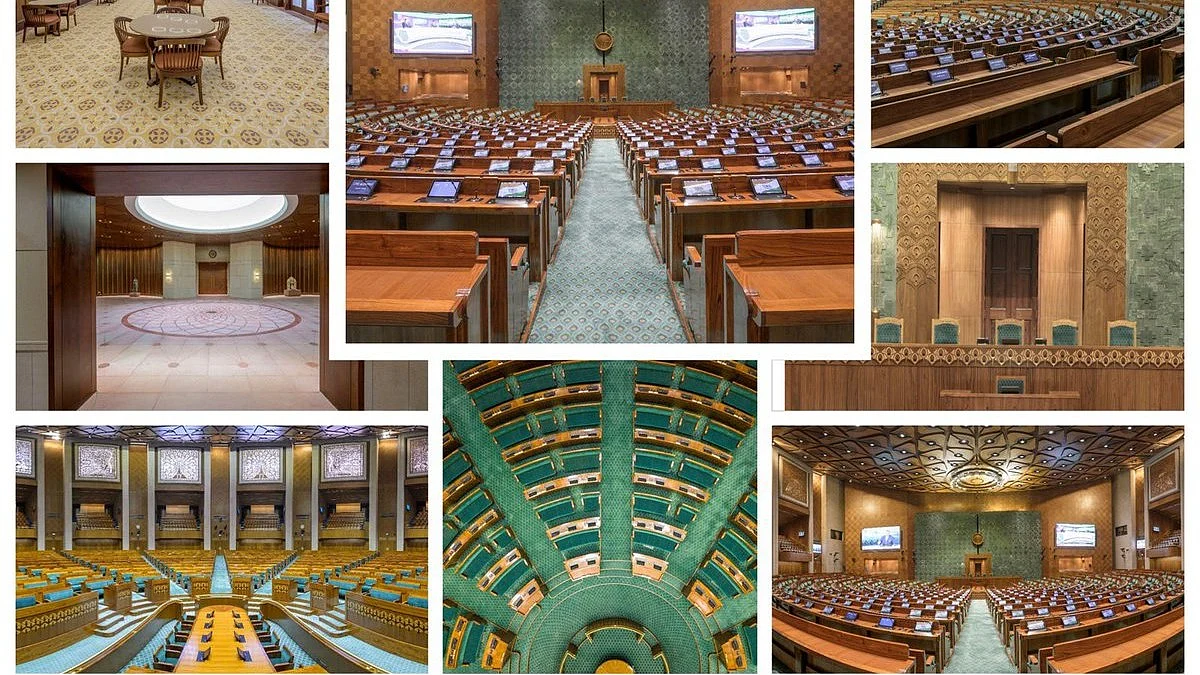New parliament building almost ignores South, East, North-East India
The ingredients of the new parliament building, being inaugurated 28 May, are meant to highlight India's diversity. But whose heritage is showcased, and whose coffers were filled?

With carpets from Mirzapur in Uttar Pradesh, bamboo flooring from Tripura and stone carvings from Rajasthan, the new parliament building that was inaugurated by Prime Minister Narendra Modi today on 28 May, is supposedly a reflection of India's diversity of artisanal and craft traditions as well.
However, some wonder about the resultant aesthetics as well as the expenses involved.
For the images shared on social media by the government in the run-up to the inauguration are curiously... bland, for a nation with so many instantly recognisable design languages. While the somber greens and ambers may be taken as some reflection of the flag colours, what explains the odd lack of familiar Indian motifs and icons?
The Lok Sabha chamber is apparently inspired by the national bird, the peacock, and the Rajya Sabha room by the national flower, the lotus. Yet the few images along the walls are all of a single aesthetic—and the ceilings' rendition quite contemporary. The paisley or ambi, a popular Indian motif across regions and traditions, seems absent. The tiger, the national animal, too is non-existent — perhaps subsumed in the lion capital out front?
But first, let us consider the sourcing of materials. This too, at least based on the information publicly available at this time, seems gap-toothed.

The teakwood used in the building was sourced from Nagpur in Maharashtra, while the red and white sandstone were procured from Sarmathura in Rajasthan (the same sort of sandstone used in the Red Fort and in Humayun's Tomb in the national capital of Delhi). The kesharia green stone has been procured from Udaipur, red granite from Lakha near Ajmer and white marble has been sourced from Ambaji in Rajasthan. So far, all westerly locations.
"In a way, the entire country came together to construct the temple of democracy, thus reflecting the true spirit of Ek Bharat Shreshtha Bharat," an official said. However, little of the local craftsmanship seems to be in evidence.
The steel structure for the false ceilings in the Lok Sabha and the Rajya Sabha chambers have been sourced from the union territory of Daman and Diu, while the furniture in the new building was crafted in Mumbai. The stone jaali (lattice) works dotting the building are from Rajnagar in Rajasthan and Noida in Uttar Pradesh.
The materials for the Ashoka emblem were sourced from Aurangabad in Maharashtra and Jaipur in Rajasthan, while the Ashok Chakra on the walls of the Lok Sabha and the Rajya Sabha chambers as well as the exterior of the parliament building were procured from Indore in Madhya Pradesh. The stone carving work was done by sculptors from Abu Road and Udaipur, and stone aggregates were sourced from from Kotputali, Rajasthan. Again, mostly western India wins, it seems.
The manufactured sand (ground from granite, rather than dredged from river beds) used in the concrete mix is from Charkhi Dadri in Haryana. The fly ash bricks used in the construction were sourced from Haryana and Uttar Pradesh too, while brass works and precast trenches were from Ahmedabad in Gujarat.
Much is made of the contributions from across the country in the construction of this building on the government's Central Vista website — which also lays out arguments about the necessity of the new building and the shortcomings of the original, as well as having a section on 'myths and realities' about the building. No mention is seen of any resources or contributions from southern or eastern India, far less the far north or the north-east.
Indeed, an installation supposedly depicting the history and heritage of this nation carries labels in only one of India's 22 official languages (Hindi in the Devanagari script) — even the names themselves, very much Sanskritised, will be largely familiar only to Hindi speakers. The map also spills well over into the sovereign territories of other nations, leading to a certain vociferous section of social media users congratulating the nation and the government on its vision of 'Akhand Bharat'. Of India the diverse nation-state, no visible evidence is seen here. One might at best term this set of friezes "reductive", and perhaps go so far as to argue it is appropriative, the opposite of syncretic.
What is also absent from the site is a break-up of the costs and the financial compensation to these various states and Union territories that have 'contributed' to the parliament building.
The total tendered cost of the building alone is Rs862 crore (though the Hindustan Times cited an actual cost of Rs971 crore) and the Central Vista project that subtends it is Rs477 crore. But what part of this went to which state and which private entities, and in what ratio, would be interesting to learn perhaps. After all, in the temple of democracy for all of India, surely an equal or better still equitable representation should be expected for all regions?
(With PTI inputs)
Follow us on: Facebook, Twitter, Google News, Instagram
Join our official telegram channel (@nationalherald) and stay updated with the latest headlines
